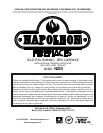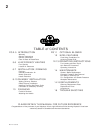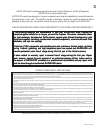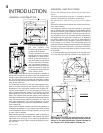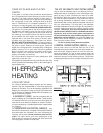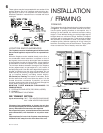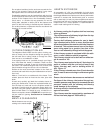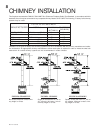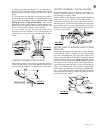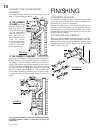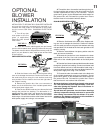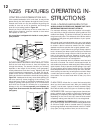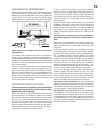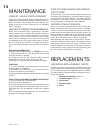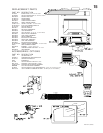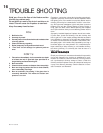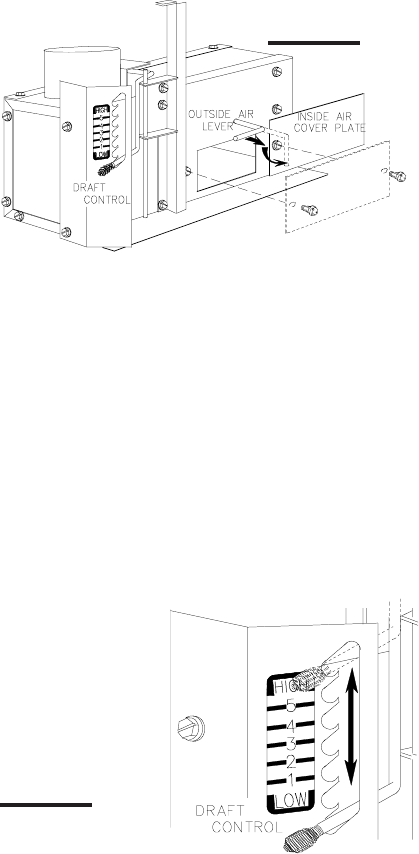
WS-415-71 / 09.07.00
12
NZ25 FEATURES
CONTROLLING COMBUSTION AIR:
If the outside combustion air kit is not used, air may still be
drawn directly into the fireplace through the lower louvres.
Outside and inside air may be combined by pulling the
outside air lever out as far as possible, and turning the
lever 90° to its locking position. Figure 22.
Should you find a frost build up on the air control box or a
draft from the fireplace, close the outside air lever when
the fireplace is not in use.
Air control box is shipped with inside air cover plate in
open position.
ACHIEVING PROPER VENTING ACTION
Draft is the force which moves air from the fireplace up
through the chimney. The amount of draft in your chimney
depends on the length of the chimney, local geography,
nearby obstructions and other forces. Adjusting the draft
control regulates the temperature. The draft can be ad-
justed from a low burn rate with the handle at the bottom
setting to a fast burn rate with the handle at the top setting.
Figure 23. Inadequate draft may cause back-puffing into
the room and may cause plugging of the chimney. Too
much draft may cause an excessive temperature in the
fireplace, glowing red fireplace parts or an uncontrollable
burn which can all lead to a chimney fire or a permanent
damage to the unit. Do not operate your fireplace for
longer than 30 minutes with the draft control on 'HIGH'
(fully open).
FIGURE 22
FIGURE 23
OPERATING IN-
STRUCTIONS
FUEL LOADING AND BURN CYCLE
WHEN LOADING THE FIREPLACE, ENSURE THAT THE FI-
BRE REFRACTORY BAFFLE IS NOT LIFTED UP.
For maximum efficiency, when the fireplace is thoroughly
hot, load it fully to the top of the door opening and burn at a
medium low setting. The bricks will be nearly all white and
the glass mostly clear. The whiteness of the bricks and the
cleanness of the glass are good indicators of your operat-
ing efficiency.
Not enough heat is produced when only one or two pieces
of wood are burned. A minimum of three pieces are needed
to encase a bed of coals that sustains the fire. Loosely
stacked wood burns quicker than a tightly packed load.
Wood burns in cycles rather than giving a steady output of
heat. It is best to plan these cycles around your household
routine so that only enough coals are left to start the next
load. In the evening, load your fireplace, at least, a half-
hour before bed to ensure a good fire that is hot enough to
close the draft control for an overnight burn.
Burn only dry seasoned wood. It produces more heat and
less soot or creosote. Do not burn ocean beach wood. Its
salt content can produce a metal eating acid. When refueling
open the door slowly to prevent smoke spillage. Use a pair
of long fireplace gloves when feeding the fire. Because
these fireplaces burn at the front, they are clean and effi-
cient, but they are also very hot and gloves are useful. Keep
a small steel shovel nearby to use as a poker and to re-
move ashes. Do not store wood within 3 feet (1m) of the
fireplace.
FLASH FIRES: A flash fire is a small fire burned quickly
when you don't need much heat. After your kindling has
"caught", load at least 3 pieces of wood, stacked loosely.
Burn with the draft control fully open or closed only slightly.
EXTENDED FIRE: Load your larger pieces of wood com-
pactly, packed close enough to prevent the flames from
penetrating it completely. After approximately 30 minutes,
depending on the size of the load, close the draft control
completely making sure that the fire is not extinguished.
DO NOT OVERFIRE THE FIREPLACE! Overfiring can occur
by: a) burning large amounts of smaller wood pieces such
as furniture scraps, skids or treated wood; b) vigorously
burning large loads of wood with the draft control on "HIGH"
(fully open) for long periods of time (one or two hours).



